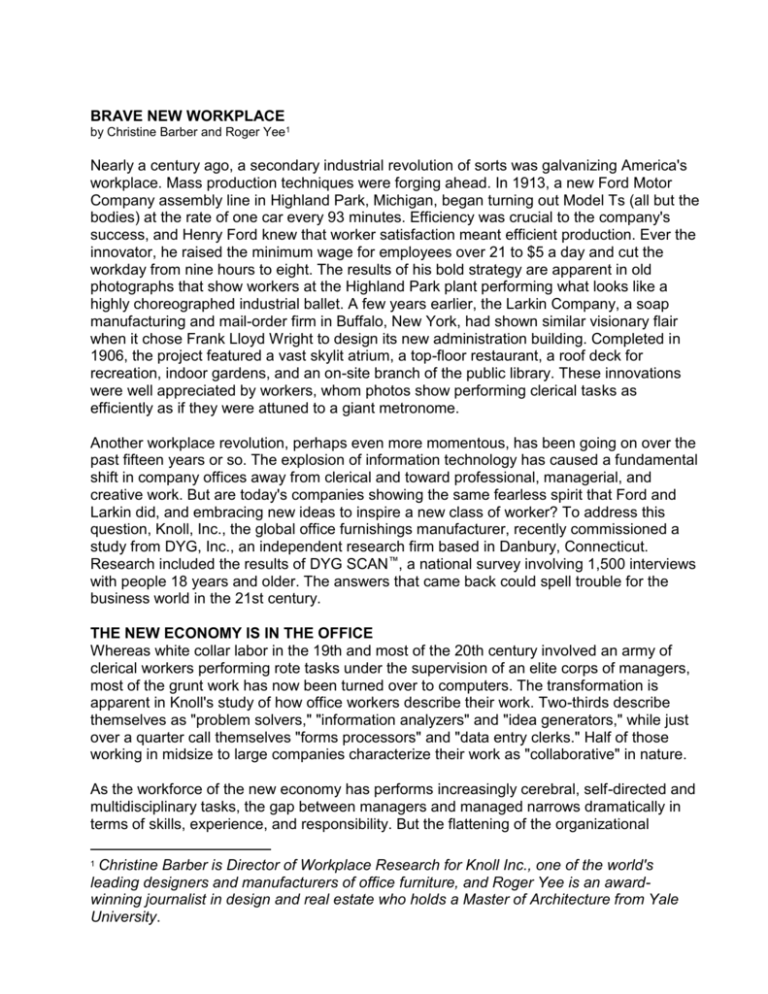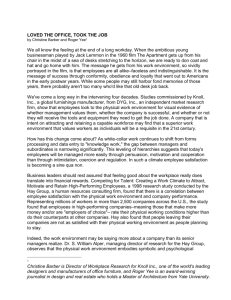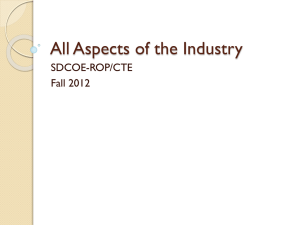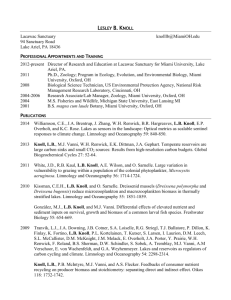BRAVE NEW WORKPLACE by Christine Barber and Roger Yee[1
advertisement

BRAVE NEW WORKPLACE by Christine Barber and Roger Yee1 Nearly a century ago, a secondary industrial revolution of sorts was galvanizing America's workplace. Mass production techniques were forging ahead. In 1913, a new Ford Motor Company assembly line in Highland Park, Michigan, began turning out Model Ts (all but the bodies) at the rate of one car every 93 minutes. Efficiency was crucial to the company's success, and Henry Ford knew that worker satisfaction meant efficient production. Ever the innovator, he raised the minimum wage for employees over 21 to $5 a day and cut the workday from nine hours to eight. The results of his bold strategy are apparent in old photographs that show workers at the Highland Park plant performing what looks like a highly choreographed industrial ballet. A few years earlier, the Larkin Company, a soap manufacturing and mail-order firm in Buffalo, New York, had shown similar visionary flair when it chose Frank Lloyd Wright to design its new administration building. Completed in 1906, the project featured a vast skylit atrium, a top-floor restaurant, a roof deck for recreation, indoor gardens, and an on-site branch of the public library. These innovations were well appreciated by workers, whom photos show performing clerical tasks as efficiently as if they were attuned to a giant metronome. Another workplace revolution, perhaps even more momentous, has been going on over the past fifteen years or so. The explosion of information technology has caused a fundamental shift in company offices away from clerical and toward professional, managerial, and creative work. But are today's companies showing the same fearless spirit that Ford and Larkin did, and embracing new ideas to inspire a new class of worker? To address this question, Knoll, Inc., the global office furnishings manufacturer, recently commissioned a study from DYG, Inc., an independent research firm based in Danbury, Connecticut. Research included the results of DYG SCAN™, a national survey involving 1,500 interviews with people 18 years and older. The answers that came back could spell trouble for the business world in the 21st century. THE NEW ECONOMY IS IN THE OFFICE Whereas white collar labor in the 19th and most of the 20th century involved an army of clerical workers performing rote tasks under the supervision of an elite corps of managers, most of the grunt work has now been turned over to computers. The transformation is apparent in Knoll's study of how office workers describe their work. Two-thirds describe themselves as "problem solvers," "information analyzers" and "idea generators," while just over a quarter call themselves "forms processors" and "data entry clerks." Half of those working in midsize to large companies characterize their work as "collaborative" in nature. As the workforce of the new economy has performs increasingly cerebral, self-directed and multidisciplinary tasks, the gap between managers and managed narrows dramatically in terms of skills, experience, and responsibility. But the flattening of the organizational Christine Barber is Director of Workplace Research for Knoll Inc., one of the world's leading designers and manufacturers of office furniture, and Roger Yee is an awardwinning journalist in design and real estate who holds a Master of Architecture from Yale University. 1 pyramid has not inspired any real change in office space. True, businesses feel compelled to invest in cutting-edge information technology to stay competitive; but they persist in seeing offices as assembly lines, rather than as think tanks, for producing knowledgebased products and services. This nurtures a curious paradox: more investment in information technology, coupled with less investment in the physical environment of the workforce. The consequences can be seen in shrinking floor area allocations, overcrowded shared spaces or group facilities, and inadequate furnishings, all surrounding the newest generation of computers and peripherals. SURPRISING FACES IN THE WORKPLACE Another profound change that has yet to influence office design has been the emergence of new demographics and shifting priorities around work and life. At a time when the business world is demanding more effort from employees while offering less security, the workforce is seriously questioning its devotion to careers and its obligation to employers. Three demographic shifts augur fundamental changes: better-educated women in the workforce, more ethnic and racial diversity, and more older workers. It is common knowledge that the ranks of women in the workforce have been growing for years. Less widely known is that working women are increasingly better educated than their male counterparts, and that they already lead in many professions formerly dominated by men. According to the National Center for Education Statistics, the percentage of bachelor's degrees earned annually by women has soared from around 43 percent of the total in 1971 to around 55 percent in 1998, with a corresponding rise in master's degrees from 40 to 55 percent. The trend is likely to increase, with the U.S. Department of Education projecting that over the next seven years there will be 9.2 million women, and only 6.9 million men, enrolled in college. Studies suggest that women hold strong convictions about the workplace that businesses may find hard to ignore. In a recent DYG study for the Ladies Home Journal, 74 percent of women aged 18–49 agree, "Increasingly, I find that I will work only for employers who allow me a certain degree of flexibility, especially regarding work hours." Sixty-nine percent aged 18–49 also insist, "In the future, I will only work for employers who let me have a real role in decision-making." In the Knoll study, 65 percent declare, "Having a nice workspace is one of the key things that help people feel better about their jobs and enjoy their jobs more"–a position shared by only 53 percent of men. Another powerful trend in the workforce is growing racial and ethnic diversity. Whereas whites have historically dominated both the general population and the workforce, other ethnic and racial groups are fast expanding their presence. The U.S. Bureau of the Census estimates that whites account for 72 percent of the population in 2000, with the balance filled by African-Americans at 12 percent, Hispanics at 11 percent, Asians at 4 percent, and Native Americans at 1 percent. By the time baby boomers start retiring en masse around 2020, the numbers will have shifted. Whites will still be in the majority, but substantial gains will have been made by African-Americans at 13 percent, Hispanics at 16 percent, and Asians at 6 percent. Only Native Americans, at 1 percent, will show no change. Significantly, though ethnic and racial shifts in the U.S. population have captured the attention of the consumer marketplace, they have failed to elicit much of a response in the office environment. Nor has the office made progress in acknowledging the graying of America, or its consequences. The U.S. Census predicts a coming tidal wave of older citizens. By 2030, over-75s will have more than doubled their number since 1998. Those aged 55–74 will have increased by 80 percent, versus only 5 percent for ages 35–54. Many of these seniors will want to keep going to the office. With or without Social Security, four-fifths of baby boomers insisted in a recent AARP survey that they plan to work during retirement, mostly in jobs other than those they retire from. Has corporate America stopped to consider the implications of having Generation Xers (currently 23- to 34-year-olds) and seniors working side by side? MORE WORK, LESS RESPECT? As the composition of the workforce changes, so do attitudes toward work. Among the social trends identified by DYG SCAN™ are a breakdown of boundaries, a weakening of hierarchy, a quest for simplification, a passionate pursuit of leisure, and a desire for personal freedom and control. All signs point to a workforce that may be in a position to insist that hard work be rewarded with straight dealing and respect, if not loyalty and affection. Led by "Gen Xers," workers young and old are striving to break down boundaries between work and personal life, integrating their daily activities as much as possible so as to get more done. They see no contradiction in having an office at home or day care at work in order to balance their time. Finding that balance may prove elusive, however. Threequarters of office workers agree, "I often feel that there is not enough time in the day to do all the things I need to do." Business is blamed for much of the burden, as nearly two-thirds of office workers declare, "Companies expect a lot more from workers today than they used to–workers are expected to get more done and get it done faster." Have businesses suffered a decline in esteem as a result of their burgeoning demands? Apparently so: Workers have lost respect for authority, with 61 percent strongly asserting, "Businesses focus too much on profits and forget about their employees and customers." The corporate world's tendency to add and subtract workers like numbers on a page results in half of office workers strongly agreeing: "Workers today have less loyalty to their companies than they used to." As a result, Gen Xers and women find themselves at the forefront of a drive toward simplification, toward reducing stress and overload in their lives. Young people often voice the hope to "make it before you're 30" and escape the rat race. Upscale men and women are buying their way out of stress through personal services, and they're willing to buy them in the workplace itself if that's where they can find them. The Knoll study found that more than half of female office workers with children would be more satisfied if there were a day care center at work; half of all office workers would be more satisfied if there were a fitness center; and one in three would be more satisfied if they were provided with an errand service. It all adds up to a passionate pursuit of leisure for Gen Xers and baby boomers (particularly men) that DYG broadly defines as "knowing how to have fun." In fact, a DYG study for Men's Health found that when asked to choose between two symbols of success, only 8 percent of men surveyed selected "a man who works 70 hours a week," while 91 percent supported "a man who achieves a more equal balance of work and play, but makes less money." Whimsy, fun and distraction at work–a seeming contradiction–will be a challenge for companies to think about in relation to the environments they create. Corporate America should hardly be taken aback by changes in workers' attitudes–it did, after all, help shape those attitudes through repeated restructuring, outsourcing and layoffs. The wonder is that corporations are so slow to recognize that their office designs remain hostage to outmoded demographics, social structure, and personal values. Their failure to adapt could cost them dearly. WHAT'S WRONG WITH TODAY'S OFFICE? Does a perfect office exist anywhere? If it does, it won't last long. Whether they move people, furniture, or both, churn is a fact of life, as organizations try to stay abreast of evolving trends. Field research by Knoll in 1995 revealed that while some 12 percent of companies never make substantial changes to their offices, 42 percent move their people, and 50 percent reconfigure their furniture, every six months or less. Much as traditionalists may protest, though, shifting furniture around won't protect the business world from change as it abandons old management theories and hierarchical structures for new ideas. Money is less an issue here than is the resistance to new concepts of organization. A major obstacle to achieving a successful work environment in the 21st century may be the business world's inability to accept the office–not the factory, not the warehouse, not the Internet–as the primary hub of economic activity in our time. How else to explain the prevalence of cost-cutting in office operations to reduce overhead, rather than investing in office capability as a technique for stimulating worker performance? In other words, today's office environment–private offices, shared enclosed spaces, openplan workstations, and desks in open areas, with the occasional conference room, executive suite or reception area–remains trapped in a time warp, while the newly emerging communal spaces and other unprecedented facilities that support analytical and creative work fall victim to cost cutting. It is as though America's CEOs were proclaiming from the penthouse office: "We don't need breakthroughs!" HOW SHOULD THE 21ST CENTURY WORKPLACE BE DESIGNED? It's no secret that some of the most successful businesses of the 20th century were born in garages. Henry Ford, Walt Disney, and Apple Computer's Steve Jobs and Steve Wozniak are but a few of the legendary entrepreneurs who have used garages as incubators. So it is understandable that some in corporate America can be downright capricious about tailoring office space to the needs of their workers. Still, there are limits. Many office workers today report a severe lack of work-related storage and desk space, coinciding with an explosion in the amount of technological hardware and wiring. Workers draw extremely negative conclusions about a company that places them in poor surroundings. This is hardly surprising, when you consider that 73 percent of them are "in the office most of the time." The physical environment forms one of the first impressions of a company, and communicates many powerful messages, including how successful the company is, whether or not management values workers, and whether they will get the tools and equipment they will need to be successful on the job. Corporate America will have to invest substantial time in addressing the problems–and the opportunities–presented by the arrival of the cerebral, self-directed, and team-oriented workforce. Early experiences of forward-thinking companies in the new economy suggest that team spaces, cafŽs, lounges, training rooms, and the like will be as important to business as traditional facilities, which will surely persist into the 21st century. Private offices seem destined to remain, since tasks requiring quiet concentration won't disappear, even in the most gregarious team settings. Status symbols such as plush spaces for VIPs can be expected to survive as well. Meanwhile, the business world could incorporate office design elements that would benefit workers immediately. Knoll questioned 350 office workers on the impact of a wide range of workspace characteristics on worker productivity and satisfaction. The responses show that the greatest boost to productivity–cited by more than 70 percent–would come from having state-of-the-art technology, the ability to control climate, storage space for work-related items, quiet space, and space that can be personalized to the occupant's work style. They assigned moderate impact (cited by 50–60 percent) to an ergonomic chair, a visually appealing workspace, lighting control, privacy, and an exterior window. Least important appears to be size–less than 40 percent of workers attributed having a large workspace, personal space for small meetings, and space for personal items as having an impact on productivity. Business leaders will observe that none of these requests for a better work environment has anything to do with enhancing personal status, which should calm fears about selfindulgent workers. On the other hand, the survey did uncover what is called the "privacy paradox." Privacy is seen as crucial to productivity by 58 percent of workers; but those currently in private offices are much more likely to say so (74 percent) than are those in cubicles (59 percent) or open areas (43 percent). Two theories advanced by DYG and Knoll are 1) self-selection, which hypothesizes that workers who need privacy will naturally gravitate to private offices, and 2) successful adaptation, which suggests that those working in open spaces have learned how to be productive with less privacy. The issue remains open to debate. Office workers responded similarly when asked which workspace characteristics had the greatest impact on satisfaction. They stressed technology, climate control, storage space, quiet space, and space that can be personalized, and added "a visually appealing workspace." These results demonstrate the close link between worker satisfaction and worker productivity; should current business conditions prevail, worker satisfaction will be a paramount consideration for the companies that create the new workplace. Where do these findings leave the business world at the dawn of the 21st century? The research by DYG and Knoll concludes that companies must reinvent the office for the Information Age. If indeed office work is becoming more cerebral, self-directed, and multidisciplinary in order to give organizations the resources they need to prosper in the new economy, then the office environment must be redesigned. Office planners should develop an environment that enhances creativity, communication, and learning. In other words, paying close attention to what office workers are required to do in the 21st-century workplace should pay as many dividends now as it did for Henry Ford at his factory in Highland Park, Michigan, nearly a century ago.









